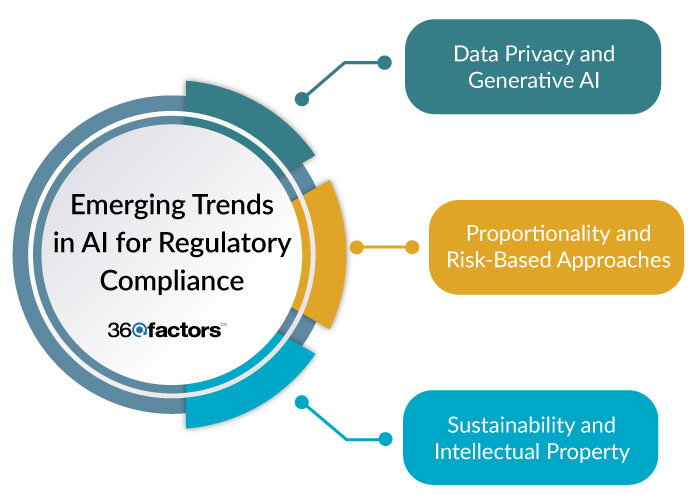Home/ Blog / The Challenges of AI for Compliance: Global Trends and Innovations
The adoption is revolutionizing financial services, advancing unparalleled efficiency, accuracy, and adaptability in managing complex regulatory landscapes. AI-driven solutions enable financial institutions to meet evolving regulatory expectations while improving operational efficiency. However, the rapid evolution of AI poses unique challenges of artificial intelligence, including governance risks, data privacy concerns, and explainability issues.
The governance of AI in financial services is a complex issue due to technology’s dynamic nature and cross-border implications. Unlike traditional regulatory frameworks designed for static, rule-based compliance, AI operates in adaptive and predictive environments, requiring continuous oversight. Regulators face the challenge of aligning AI policies across different global jurisdictions, with some preferring principle-based guidelines while others enforce strict, rules-based AI governance. As a result, financial institutions must balance AI-driven innovation with ethical, fair, and transparent compliance practices to avoid regulatory breaches.
This blog explores core themes in global AI guidance and emerging trends in AI for regulatory compliance. Let’s delve into the discussion:
Core Themes in Global AI Guidance for Compliance
As AI becomes integral to financial services, global regulatory bodies define key principles to ensure responsible adoption, a common theme in AI governance.
Transparency and Explainability
Transparency in AI compliance operates on two levels: internal transparency for governance and external transparency for customer trust. Internally, organizations must ensure clear documentation, interpretability, and auditability of AI models. AI decisions affecting compliance, such as credit risk assessments, should be explainable to compliance teams, auditors, and regulators. Without internal transparency, organizations risk using AI in ways that violate regulatory expectations.
Externally, AI explainability is vital for maintaining customer confidence. Regulators require financial institutions to disclose when artificial intelligence influences decisions affecting customers, such as loan approvals. AI-driven decisions must be interpretable and communicated in plain language, ensuring customers understand how AI affects them. However, one of the challenges of artificial intelligence is balancing explainability with system sophistication. As AI models grow in complexity, striking a balance between explainability and system sophistication remains challenging. Regulators are encouraging the use of explainability tools and human oversight to improve clarity.
Accountability and Governance
AI accountability relies on clear governance structures that define roles and responsibilities across financial institutions. Regulatory bodies expect AI decision-making to be monitored and controlled, ensuring organizations can justify AI-driven compliance actions.
A key focus is human oversight in regulatory compliance systems, mainly through “human-in-the-loop” (HITL) and “human-in-control” (HIC) models. HITL ensures human intervention in AI decision cycles, preventing AI from making unchecked compliance decisions. HIC extends this principle by requiring humans to have ultimate control over high-risk AI decisions. These approaches reduce compliance risks associated with AI bias, model drift, or erroneous decisions.
Regulatory guidelines also direct that organizations maintain audit trails and AI model versioning, ensuring that AI processes are transparent and traceable. Organizations must document AI training data, decision rationales, and updates, allowing regulators to assess AI-driven compliance processes effectively.
Fairness and Ethics
AI fairness is critical to prevent discriminatory or biased decision-making in financial services. Regulators emphasize two types of fairness:
- Procedural fairness ensures that AI-driven compliance processes follow unbiased and standardized procedures.
- Distributive fairness ensures AI decisions do not disproportionately impact certain demographic groups, particularly in credit assessments.
To uphold fairness, organizations must evaluate training data for biases, implement bias-detection models, and apply corrective measures when disparities are detected. Ethical AI principles also extend to data privacy, diversity, and societal norms, ensuring AI systems align with GDPR and other data protection regulations. However, one of the challenges of artificial intelligence is ensuring fairness while maintaining AI efficiency and scalability. As AI models evolve, organizations must strike a balance between automated decision-making and ethical oversight to avoid unintended biases and discriminatory practices.
Security and Safety
AI security is a growing regulatory concern, particularly in protecting AI-driven compliance tools from cyber risks, adversarial attacks, and misuse. To prevent regulatory breaches, AI models must meet strict data security and operational resilience standards.
Data protection is crucial as AI regulatory compliance relies on vast datasets for decision-making. Regulatory frameworks require institutions to encrypt, anonymize, and restrict access to sensitive financial data, preventing unauthorized AI model manipulation.
Operational resilience is another priority, ensuring AI-driven compliance functions can withstand system failures or cyberattacks. Regulators require fail-safe mechanisms, audit trails, and contingency plans to maintain compliance integrity even in AI disruptions.
Emerging Trends in AI for Regulatory Compliance
As the adoption of AI reshapes regulatory compliance, global regulators are evolving their frameworks to address new risks and opportunities. Emerging trends highlight key areas of concern.

Data Privacy and Generative AI
The rise of generative AI (GenAI) has raised significant concerns about personal data usage, ownership, and protection. GenAI systems rely on vast datasets, often including personal and proprietary information, to generate human-like content. However, this poses privacy risks, primarily when AI models inadvertently process sensitive financial data or customer information.
Regulatory bodies emphasize the need for data protection frameworks to address the challenges of artificial intelligence usage in regulatory compliance functions. Key requirements include:
- Data Ownership and Usage Rights: Financial institutions must ensure AI models comply with data sovereignty laws and obtain explicit consent before processing personal data.
- Right to Correction and Deletion: Customers and institutions must have mechanisms to correct AI-generated errors or request deletion of AI-processed personal data, aligning with GDPR and similar regulations.
- Secure Model Training Practices: Regulators encourage artificial intelligence models to use synthetic or anonymized data instead of accurate personal data to mitigate privacy risks.
Proportionality and Risk-Based Approaches
Regulators are adopting proportionality and risk-based approaches to ensure AI regulations are tailored to the risk level of specific applications. Instead of one-size-fits-all AI compliance rules, regulators differentiate between low-risk and high-risk AI use cases.
Low-risk AI applications (e.g., internal process automation, chatbot customer support) may have fewer compliance burdens, allowing organizations to deploy AI efficiently.
High-risk AI applications (e.g., AI-driven credit scoring, automated trading, fraud detection) face stricter regulatory scrutiny due to potential financial, ethical, or security risks.
Sustainability and Intellectual Property
As AI adoption grows, regulators increasingly address AI’s environmental impact and intellectual property (IP) compliance. The computational power required to train large AI models leads to high energy consumption, raising concerns about sustainability in AI development. Additionally, ensuring compliance with copyright laws presents another challenge of artificial intelligence, as AI models often rely on vast datasets that may include proprietary content.
To mitigate these issues, regulatory frameworks now encourage:
- Energy-efficient AI practices: AI providers are expected to disclose their carbon footprint and use green AI solutions to optimize energy consumption.
- Intellectual property compliance: Organizations must ensure GenAI models do not infringe on copyrights, requiring transparency in data sourcing, licensing, and attribution.
- AI transparency and ethical data use: Financial institutions must document AI models’ training data sources and verify compliance with IP laws to prevent copyright disputes.
Implementing AI-Powered RCM Tool for Streamlined Process
As AI regulations continue to evolve, financial institutions need robust solutions to track, assess, and implement regulatory changes effectively. Regulatory Change Management (RCM) tools help organizations stay ahead of regulatory updates, ensuring that regulatory compliance processes align with new and emerging global standards.
Keeping up with evolving AI governance and regulatory requirements can be overwhelming without a structured approach. By leveraging automated insights and risk-based assessments, financial institutions can enhance compliance efficiency and reduce operational complexity.
Streamline AI Compliance with Predict360 Regulatory Change Management Software
Evolving AI regulations necessitate a proactive and efficient approach, such as implementing RCM software. However, one challenge of artificial intelligence in compliance management is keeping pace with rapidly changing regulatory landscapes while ensuring AI-driven decisions remain transparent and auditable.
Predict360 Regulatory Change Management Software provides financial institutions with comprehensive regulatory intelligence, automated compliance tracking, and real-time impact assessments, all within a unified platform.
With its intelligent regulatory updates, compliance teams receive automated alerts on new and emerging AI regulations, ensuring timely action. The platform offers impact assessment, which maps regulatory changes to specific policies, risk areas, and business units, reducing compliance gaps. The platform’s AI-driven chat-based assistant, Kaia, enhances regulatory understanding by providing context-specific answers to compliance queries.
Request a Demo
Complete the form below and our business team will be in touch to schedule a product demo.
By clicking ‘SUBMIT’ you agree to our Privacy Policy.



